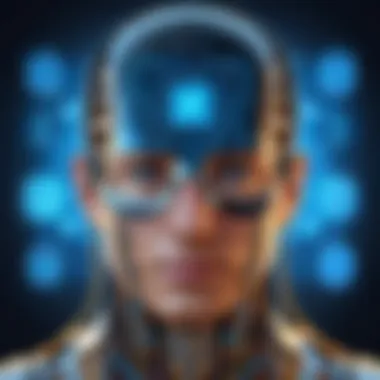Exploring Jeremy Howard's Impact on Deep Learning


Intro
In exploring the contribution of Jeremy Howard to deep learning, one comes across an intricate tapestry of innovation and education. Jeremy, co-founder of fast.ai, has been insistent on not just making deep learning accessible but also ensuring that it has practical applications in various sectors. He plays a pivotal role in reshaping the landscape of machine learning education, breaking down complex concepts into digestible chunks for an audience that spans from fresh-eyed students to seasoned experts. This article will traverse through his methodologies, the tools he developed, and the implications of his work.
Technology Insights
Latest Tech Trends
With technology advancing at breakneck speed, keeping abreast of latest trends is crucial. Howard's fast.ai course is a prime example of cutting-edge education tailored to the needs of today's learners. He champions the idea that deep learning should be within reach of all, not just those with a PhD.
- Democratization of AI: Howard believes in breaking down barriers to entry. This is evident through his open-access courses which allow anyone, regardless of background, to dive into AI tech.
- Focus on Real-World Applications: Instead of merely teaching theory, he emphasizes practical use cases. From image recognition to natural language processing, learners are guided to apply their knowledge immediately.
Innovation in Tech
Jeremy Howard isn’t just a teacher; he’s a pioneer. His contributions to the field of deep learning go beyond just educational initiatives.
- fastai Library: The fastai library simplifies the process of training neural networks, allowing users to build sophisticated models with minimal code. It abstracts away the complexities without sacrificing control.
- Community-Driven Development: His approach encourages contributions from learners and industry experts alike, leading to constant refinements and updates in the tools provided.
Product Reviews
In the realm of machine learning, it's essential to have the right tools at your disposal. One standout product within Howard’s offerings is the fastai library. Its intuitive design and accessibility make it an indispensable resource for aspiring data scientists.
"With fastai, you can go from zero to deep learning in just a few coding hours."
The community support surrounding fastai, bolstered by forums and discussion boards, provides real-time solutions and guidance.
Implications for Education
Jeremy Howard’s initiatives have broader implications for education. By making deep learning comprehensible, he not only fuels interest in the field but also prepares a new generation of technologists to meet industry demand. This journey demonstrates the importance of making complex topics available to the masses.
As Jeremy Howard continues to impact education and industry, we can expect to see further shifts in how machine learning is approached both academically and professionally. His work thus paves the way for innovations that will profoundly influence our ability to use AI responsibly and effectively.
By not just changing the technical landscape, but also emphasizing accessibility, he is fostering an environment where creativity and practicality in technology thrive.
Prologue to Deep Learning
Deep learning has transformed not just the landscape of technology but also the fundamental approach to problem-solving across various sectors. It has provided the backbone for advancements in fields like computer vision, natural language processing, and more. By delving into the intricacies of deep learning, we uncover methodologies and insights that empower both individuals and businesses to make informed decisions and innovate at unprecedented rates. This article sheds light on the contributions of one significant figure in this domain, Jeremy Howard, whose efforts have made deep learning more accessible to a broader audience.
Defining Deep Learning
Deep learning is a subset of machine learning that imitates the workings of the human brain in processing data and creating patterns for use in decision making. At its core, deep learning utilizes neural networks with several layers to undertake mathematical computations on data. These computations help analyze, learn, and mimic complex structures and behavior that were previously hard for computers to decode. The key characteristic here is the ability of these algorithms to learn representations of data automatically, thus removing the need for extensive manual feature engineering.
Categories of Deep Learning Algorithms
Deep learning isn't a one-size-fits-all solution; rather, it comprises several approaches tailored to various tasks. Understanding the main categories helps researchers and practitioners effectively apply the right techniques to the right problems. Here's a closer look at the three primary categories of deep learning algorithms:
Supervised Learning
Supervised learning is perhaps the most straightforward approach within deep learning. This method involves training a model on a labeled dataset, meaning each training example is paired with an output label. The primary goal is for the model to make accurate predictions or classifications based on new, unseen data. One of the key characteristics of supervised learning is its ability to harness historical data to learn relationships and patterns, making it a popular choice for tasks such as image classification or spam detection.
The unique feature of supervised learning lies in its reliance on labeled datasets. While this often results in high accuracy and reliability when deployed in real-world applications, a significant disadvantage is the abundant requirement for labeled data, which can be costly and time-consuming to obtain.
Unsupervised Learning
In contrast, unsupervised learning takes a different approach. Instead of relying on labeled input data, this method works with datasets that lack any explicit annotations. The primary objective here is to discover underlying patterns or structures within the data. For instance, clustering algorithms like k-means help to segment customers based on purchasing behavior without needing predefined groups.
The key characteristic of unsupervised learning is its flexibility in dealing with raw data. This opens the door for extensive exploratory analysis and pattern recognition. However, its unique feature also poses challenges, as the absence of labels makes it difficult to evaluate the model's performance effectively, potentially leading to ambiguous interpretations.
Reinforcement Learning
Reinforcement learning (RL) marks another evolution in how models learn from environments. Instead of learning from labeled datasets or just discovering patterns, RL relies on a set of actions, states, and rewards. Algorithms interact with their environment and gradually learn to make decisions that maximize cumulative rewards. The unique feature here is the trial-and-error method, which allows models to explore many possibilities and fine-tune their strategies over time.
What makes reinforcement learning particularly appealing is its application in areas such as robotics and game-playing, where models can continuously learn from their environment. However, this approach can be computationally intensive and requires substantial experimentation, which may not always be practical for straightforward tasks.
Jeremy Howard: A Brief Biography
Understanding the life of Jeremy Howard provides valuable context for his contributions to deep learning and the broader AI community. His journey from a tech enthusiast to a significant figure in machine learning education is not only fascinating but also showcases how one's background shapes their endeavors. Every step of his career is like a thread in a larger tapestry that communicates the importance of accessible and practical education in a field that is often deemed esoteric.


Early Career and Education
Howard's story begins with his unassuming academic background. He graduated with a degree in commerce from the University of New South Wales. Initially, he didn’t venture directly into technology. Instead, he focused on building his own path, exhibiting entrepreneurial spirit from the get-go. It was during his early career that the seeds for his later work in AI were sown. He wore multiple hats in various roles, ranging from consulting to founding companies, each adding layers to his understanding of both technology and business.
He quickly realized that the tech world was where his true passion lay. This early exposure established a foundation for his future endeavors as he began delving into data science and machine learning, self-educating through hands-on projects and online resources. Howard’s background in commerce provided him with a unique perspective on how technology intersects with real-world applications, a theme that would surface consistently throughout his work.
Founding Kaggle
The establishment of Kaggle marked a pivotal moment in Howard’s career. In 2010, he co-founded the platform, aiming to create a space where data scientists could connect, collaborate, and compete on various machine learning challenges. This move didn’t just reflect Howard's ambition; it also illuminated his belief in the collaborative spirit of data science.
Kaggle quickly evolved into a rich ecosystem that democratized access to data science and machine learning. It enabled individuals from diverse backgrounds to showcase their skills and innovate in the field, transforming the dynamics of data competition.
Howard’s ingenuity in creating Kaggle resonated well within tech communities. It provided not only a competition stage but also a wealth of shared knowledge and resources. People across the globe began participating, bridging gaps between novices and seasoned experts. This significant practical learning environment helped cement Howard's position as a pioneer in making deep learning accessible to a wider audience.
Development of fastai
While Kaggle revolutionized the way data science is viewed, Howard didn’t stop there. He recognized a gap in the educational materials available for deep learning. In 2016, he launched fastai, a library that simplifies deep learning for practitioners. Fastai promotes the concept of learning from the top down—focusing on practical applications with less emphasis on steep theoretical backgrounds.
The core idea behind fastai is straightforward: make deep learning accessible for all. Howard designed the library around user experience and simplicity, allowing newcomers to harness powerful deep learning techniques with minimal barriers to entry. This level of accessibility has encouraged a new wave of learners and innovators, who otherwise might have felt apprehensive about entering the deep learning field.
Fastai not only simplifies the technical aspects but also fosters a supportive community. By providing extraordinary educational resources, courses, and an active forum, Howard and his collaborators have made it possible for individuals to teach and empower others, further extending the impact of AI in practical scenarios.
The biography of Jeremy Howard encapsulates a narrative of determination, creativity, and accessibility. His work exhibits a clear dedication to enriching the field of AI while ensuring that everyone, regardless of their starting point, can participate and thrive. Through his initiatives, Howard has made profound strides in democratizing deep learning, and this legacy will likely resonate for years to come.
Learning Frameworks: Fastai and Its Impact
Fastai stands as a beacon in the complex realm of deep learning frameworks, making significant waves since its inception. This section sheds light on its importance and the unique advantages it brings to both newcomers and seasoned practitioners in artificial intelligence.
What is fastai?
Fastai is an open-source library designed to streamline the process of building models in deep learning. Developed by Jeremy Howard and the team at fast.ai, it provides a flexible, high-level interface to the lower-level libraries such as PyTorch. The goal? To make deep learning accessible, comprehensible, and practical for all, regardless of one’s prior experience.
In the heart of its utility lies the philosophy that anyone can harness the power of machine learning. Fastai’s structure allows users to build models without diving deep into the overwhelming sea of mathematics and programming proficiency typically required.
User-Centric Design in fastai
Fastai's user-centric design sets it apart from its competitors. It's designed with the end-user in mind, creating a smooth learning journey. For instance, instead of imposing a steep learning curve, fastai enables users to achieve results quickly. Features like the class abstract away much of the complexity. Users can treat their data like a black box, focusing more on outcomes rather than technicalities.
Moreover, the library encourages experimentation. You can easily tweak parameters, switch architectures, or even modify loss functions on the fly. This flexibility fosters creativity, pushing users to explore and test various configurations without the hassle of going back to the drawing board.
Community Contributions and Resources
The fastai community is one of its most significant assets. A vibrant group of enthusiasts and experts contribute valuable resources. When you join the community, you're not merely an observer; you're part of a farm of shared knowledge. The platform hosts a myriad of tutorials, discussions, and forums where users may ask questions and share insights.
"The best part of the fastai ecosystem is the collaborative spirit. It’s like walking into a workshop where everyone is ready to lend a hand."
Additionally, fastai provides extensive documentation, guiding users through various aspects of deep learning. Coupled with an active community on platforms like Reddit, users can easily find support and camaraderie as they delve into the complexities of machine learning.
However, it’s essential to note that while fastai eases many burdens, a foundational understanding of deep learning principles is still beneficial. Understanding how the tools work under the hood can bolster one’s effectiveness and adaptability when applying fastai’s concepts to real-world scenarios. The community’s resources often emphasize this crucial balance between simplicity and depth.
Teaching Methodologies in Deep Learning
Jeremy Howard’s contribution to deep learning isn’t just in the algorithms or the code he writes. It's also about how he teaches and shares knowledge. The methodologies he employs bring a practical approach that resonates with learners from all walks of life. It’s crucial because it ensures that complex topics in deep learning become digestible and accessible, especially for those who might not have a robust technical background.
The importance of effective teaching methodologies cannot be overstated. In a field that evolves as quickly as deep learning, having structured and clear teaching methods means more people can jump on board and contribute without overwhelming confusion. Howard’s approach thrives on several elements:
- Practical Engagement: Learning by doing is often more effective than theory alone. Hands-on experiences solidify concepts and make them memorable.
- Accessibility: By breaking down intricate topics into bite-sized pieces, Howard ensures that learners at various levels can grasp the core ideas and technologies behind deep learning.
- Interactivity: Encouraging discussions and collaborative projects fosters a more engaging learning atmosphere, often leading to deeper understanding.
A focus on these elements can bridge the gap between theory and real-world application, showcasing the enormous potential of deep learning in various industries.
Howard’s Approach to Education
Howard is a firm believer that education should not be a gatekeeping mechanism. In his work with fastai and Kaggle, his educational philosophy is patient and nurturing, steering clear of traditional lecture methods that tend to put students to sleep. Instead, he champions a hands-on, project-based approach where students learn by creating their own models instead of just memorizing principles.
His courses often include:
- Interactive coding environments: This allows learners to experiment while they learn.
- Real-time feedback: By providing immediate responses to students' queries, it aids in quicker learning.
- Community-driven support: Engaging a supportive network helps learners not feel isolated in their educational journey.


Essentially, Howard’s style leans heavily into making learning a shared experience, where knowledge is not just transferred but collaboratively built.
Hands-On Projects and Real-World Applications
Deep learning can seem abstract at times, hence Howard emphasizes the importance of hands-on projects. Learning through real-world applications not only solidifies understanding but also showcases how deep learning affects various sectors.
By grounding the lessons in projects, learners engage with:
- Image classification tasks using libraries like fastai, helping students create their own image recognizers.
- Text generation models, where they understand how neural networks can produce human-like text based on input data.
- Predictive analysis in healthcare, looking at datasets that help in clinical decision-making tools.
"Education is not the filling of a pail, but the lighting of a fire." — William Butler Yeats
Through these projects, students gain first-hand experience of how theory translates into action. They see the impact of their work and realize the vast possibilities of deep learning. Furthermore, these experiences are crucial for building a portfolio that speaks volumes in a competitive job market. The connection to real-world use cases keeps learners motivated and focused on achieving tangible outcomes.
In summary, Howard’s teaching methodologies embody a holistic view of education in deep learning. They emphasize comprehension, interactivity, and practical application, preparing students not just for exams, but for a life of innovation in the field.
The Ethical Considerations in AI Training
The integration of artificial intelligence into various sectors has raised critical ethical questions that cannot be ignored. The ethical considerations in AI training are foremost in the conversation regarding deep learning, especially given the repercussions of potential misuse. This section delves into the significance of addressing bias in AI and Jeremy Howard’s initiatives to promote responsible use of these technologies. By understanding these ethical facets, we can better appreciate how they intertwine with the evolution of AI applications.
Bias in Machine Learning
Bias in machine learning is like a double-edged sword. On one side, algorithms can process immense data and find patterns that may have gone unnoticed by the human eye. On the other, if the data used for these algorithms is skewed or unrepresentative, we might end up reinforcing stereotypes or amplifying discrimination. The essence of this bias comes from the data that machines learn from, and if that data reflects existing societal prejudices, the decisions made by AI systems will echo those biases.
Some examples include:
- Facial Recognition: Studies showed that certain facial recognition systems misidentify individuals of specific ethnicities more often than others, leading to concerns over use in law enforcement.
- Hiring Algorithms: If training data includes historical hiring practices that favor a certain demographic, the algorithm might inadvertently discount qualified candidates from underrepresented groups.
From these implications, it’s clear that bias isn’t just a technical glitch; it can materially affect people’s lives. The need for conscious effort in selecting unbiased datasets is paramount. Ensuring fairness and equality in machine learning must therefore be at the forefront of AI training practices.
Howard’s Advocacy for Responsible AI
Jeremy Howard stands as a beacon of hope in the AI landscape, advocating for responsibility and ethics in AI training. He tirelessly emphasizes that AI technologies, while powerful, must be harnessed with a moral compass. One of his significant contributions in this field is his promotion of transparency and accountability.
Howard aims to:
- Educate Practitioners: By teaching developers and data scientists about the potential ethical pitfalls of their work, he strives to instill a sense of responsibility.
- Develop Better Algorithms: Through frameworks like fastai, he encourages techniques that facilitate fairness, ensuring that the models built are ethically sound and don’t propagate bias.
- Engage in Dialogues: He often partakes in discussions and forums that address the broader implications of AI on society, focusing not just on technological advancements but on the societal impacts these technologies hold.
"Ethics should be integral to AI’s development, not just an afterthought."
In summary, Howard’s advocacy resonates through his work and education, emphasizing a balanced approach to AI development. He instills the idea that as deep learning continues to advance, it must do so ethically, creating a future where technology uplifts rather than oppresses.
Emerging Trends in Deep Learning
Emerging trends in deep learning are not just fascinating developments; they serve as the backbone of future innovation in the realm of artificial intelligence. As technology evolves, so too do the techniques and methodologies that drive it. This section sheds light on two of the most significant trends gaining traction in contemporary research and application: transfer learning and generative adversarial networks (GANs).
These trends are vital for several reasons. First, they improve the efficiency with which models learn from data. Thanks to advancements in deep learning, researchers and practitioners can leverage pre-trained models and apply them to new tasks with minimal adjustments. Additionally, these trends open doors to new applications—ranging from image recognition to natural language processing—that were previously challenging to achieve.
Moreover, the implications of these advancements extend beyond academic circles, impacting industries like healthcare, marketing, and autonomous systems. As we delve into the specific elements of transfer learning and GANs, it becomes clear that understanding these trends is essential for anyone looking to make waves in AI.
Transfer Learning and Its Implications
Transfer learning is a strategy that allows models to apply knowledge gained in one domain to a different but related domain. Rather than starting from scratch—an incredibly resource-intensive process—practitioners can utilize a model trained on a large dataset and fine-tune it for their specific needs.
For instance, if a neural network has been trained on millions of images, one could fine-tune this model on a smaller dataset pertinent to a niche area. This significantly reduces the time and resources needed for training. The implications here are profound:
- Efficiency: Less computational power and time needed.
- Accessibility: Smaller organizations can harness advanced technologies without needing vast datasets.
- Accuracy: Improved results as the model builds off prior learning.
To illustrate, in the medical field, a model trained on general medical images can be adapted to identify specific diseases in rare conditions. The power of transfer learning is changing the landscape of AI, enabling broader application of machine learning solutions.
Generative Adversarial Networks (GANs)
Generative Adversarial Networks, or GANs, represent a disruptive innovation in the sphere of deep learning. By pairing two neural networks—one generating new content and the other evaluating its authenticity—GANs are capable of creating astonishingly lifelike images, music, and even text. This architecture not only showcases the might of neural networks but also highlights the potential for creativity in artificial intelligence.
The architecture operates under a simple premise: two adversaries engage in a game where the generator tries to create data that mimics a real dataset, while the discriminator attempts to discern which data is real and which is generated. Over time, both networks improve—yielding increasingly sophisticated outputs. This is not just a tech novelty; the implications of GANs are extensive:
- Art and Content Creation: Artists and designers utilize GANs to develop new forms of art and design.
- Drug Discovery: In pharmaceuticals, GANs can help synthesize molecules that could lead to new medications.
- Realistic Simulation: GANs aid in creating training data for autonomous systems, which rely on accurate simulations to operate effectively.


“GANs have the potential to revolutionize visual creation, allowing for groundbreaking advancements across industries.”
By appreciating these emerging trends—transfer learning and GANs—individuals and organizations can more effectively navigate the shifting landscape of AI. Understanding these concepts is crucial not only for those in academia and research but also for industry practitioners who aspire to integrate innovative solutions within their work.
Howard’s Influence on the AI Community
Jeremy Howard has become a cornerstone in the landscape of artificial intelligence, particularly in the realm of deep learning. His multifaceted contributions have not only pushed the boundaries of the field but have also catalyzed a shift in how individuals engage with machine learning, making it more accessible and applicable. Howard’s influence can be felt through various platforms, ranging from academic circles to practical industry applications. This section explores the crucial aspects of his impact within the AI community, emphasizing both the benefits and considerations that arise from his extensive engagement.
Contributions to Conferences and Publications
From the early days of his career, Jeremy Howard recognized the importance of sharing knowledge within the community. His presentations at major conferences have been likened to a breath of fresh air in the often complex and jargon-laden field of AI. Howard’s ability to break down intricate concepts into digestible insights enables not just seasoned experts but also newcomers to grasp and contribute to the dialogue surrounding deep learning.
Prominent conferences, such as NeurIPS and ICML, have seen Howard present innovative research and methodologies. His papers often explore new territories in machine learning, allowing attendees to gain fresh perspectives. He has been known to cover:
- New techniques in transfer learning
- Advocating for open-source resources and tools that enhance collaborative learning
- Implementing practical examples that demonstrate real-world applications of theoretical concepts
Howard’s publications serve as a repository of knowledge that continually inspire educators and researchers alike. His knack for distilling complex topics into relatable content works in favor of training the next generation of data scientists. > By challenging existing narratives and promoting a culture of shared learning, Howard is actively reshaping the fabric of the AI community.
Mentorship and Collaboration
Another vital aspect of Howard's influence on the AI community lies in his commitment to mentorship and collaboration. He has fostered an environment where knowledge is shared freely, promoting a spirit of cooperation across various projects. Howard has often stated, "The best learning happens when we teach one another." This ethos is reflected in his initiatives, particularly within fastai, where support and guidance are cornerstones of the learning experience.
Mentorship goes beyond merely offering advice or conducting workshops; it's about creating a supportive ecosystem. Howard has been instrumental in:
- Leading study groups that focus on hands-on projects, enhancing peer-to-peer learning
- Collaborating with industry professionals to bridge the gap between academia and practical applications
- Encouraging underrepresented groups to join the field, thereby diversifying perspectives and ideas
The ripple effect of Howard's mentorship can be seen in numerous success stories, where individuals have transformed their careers under his guidance. From data scientists to ML engineers, many have credited him with fostering their growth, highlighting that mentorship isn't just about imparting knowledge; it's about inspiring confidence and creativity.
Through these avenues, Howard has not only contributed to personal growth within the AI community but has also made strides in ensuring the field remains dynamic and diverse. His legacy is evident in how emerging talents are shaping the future of AI, fueled by a sense of camaraderie and shared purpose.
Future Directions in Deep Learning
The domain of deep learning is evolving at breakneck speed. As technology advances and transforms various sectors, the future pathways in deep learning are becoming more than just a matter of academic interest; they are crucial for real-world applications. By examining where deep learning is heading, we can not only anticipate upcoming trends but also identify potential innovations that could reshape the technological landscape.
As we delve into specific elements and considerations regarding the future of deep learning, it becomes clear how vital these discussions are.* Future Directions in Deep Learning* isn't just about what tools may arise; it's also about understanding the impact these advancements have across different industries—from healthcare to finance, and beyond. There’s an ongoing dialogue about making AI more transparent and responsible, which means deeper collaboration between technologists and policymakers is essential.
Potential Innovatives in the Field
Artificial intelligence, particularly through deep learning, has spurred a number of groundbreaking innovations. Here are some potential avenues that may see significant growth:
- Explainable AI (XAI): The demand for systems that can explain their decisions grows, especially as deep learning models often act as black boxes. Developing methods to clarify these decisions will enhance trust and usability in many sectors like medicine and finance.
- Federated Learning: This paradigm allows models to learn from decentralized data without compromising privacy, making it a game-changer in sectors handling sensitive data, such as banking or personal health information.
- Neural Architecture Search: Automating the design of neural networks could streamline the development process and tailor solutions to specific tasks, making it easier for developers with varying expertise levels to create effective models.
- Multimodal Learning: As different types of data (text, audio, visuals) become interwoven, creating models that can understand and analyze across these modalities will likely gain traction, leading to enhanced capabilities in applications such as self-driving cars and smart assistants.
These innovations have the potential to not just improve efficiency but also spark entirely new applications we may not have thought possible.
Howard’s Vision for AI Development
Jeremy Howard has consistently advocated for the responsible development and deployment of AI technologies. He envisions a future where AI democratization plays a central role, allowing individuals and businesses, regardless of size, to leverage deep learning.
Howard emphasizes the importance of making AI education accessible. He believes that equipping more people with the necessary skills can drive innovation from grassroots levels. He is particularly optimistic about platforms like fastai, which aim to simplify the complexities involved in deep learning, thereby empowering enthusiasts and professionals alike.
He also stresses that as AI systems become more beneficial, there needs to be a parallel strategy that focuses on ethical considerations. Ethical AI isn't just a buzzword; it’s a necessity. With an eye on the socio-economic implications of technology, Howard advocates for policies that ensure equitable access, usage, and protections against biases in machine learning models.
"The more we can involve a diverse range of voices in the AI conversation, the better our chances for a beneficial outcome for everyone," says Howard.
Culmination: The Legacy of Jeremy Howard
In dissecting the contributions of Jeremy Howard to deep learning, one can clearly see the ripple effects of his work resonating within the broader AI community. Howard is not merely a figure in the background; his footprints in education, societal impact, and the technical advancements of deep learning algorithms are significant. A proper examination of his legacy leads to a discussion surrounding several key elements: the democratization of AI, innovative pedagogical approaches, and an invigorated community focused on responsible development.
Summarizing Contributions and Impact
Howard’s contributions are vast and varied, ranging from the founding of Kaggle, which functions as a global platform for data science practitioners to share challenges and collaborate on solutions, to creating fastai—an open-source library designed to simplify deep learning applications. His inputs serve not just technical realms but stretch into making AI more accessible to non-experts, thereby broadening the talent pool in artificial intelligence fields.
"Education is not the filling of a pail, but the lighting of a fire."
—William Butler Yeats
The initiatives Howard champions emphasize practical applications of deep learning that allow students and professionals to engage with real-world problems. His patronage of hands-on projects throughout his teachings is noteworthy; they give learners the chance to apply theoretical knowledge directly.
Moreover, his stance on the ethical implications of AI—like addressing biases and advocating for responsible AI—ensures that as the technology evolves, it does so with a conscience. This holistic approach echoes across institutions and industries that look up to Howard’s model for guidance.
The Future of Deep Learning
Looking forward, the trajectory of deep learning is influenced heavily by Howard's vision. The trends signal a movement towards greater integration of AI in everyday applications, whether through automation in businesses or advancements in healthcare. Emerging technologies such as transfer learning and GANs are reshaping how we perceive machine learning. Howard advocates for future innovations to be centered on democratization, ensuring these advancements are available to a broader audience.
As AI continues to develop and adapt, Howard’s insistence on a focus rooted in accessibility promises to empower a new generation of thinkers and developers in the field. The challenge remains: balancing this accessibility while maintaining high ethical standards and responsible deployment. These considerations are paramount as we embrace the future of deep learning.







